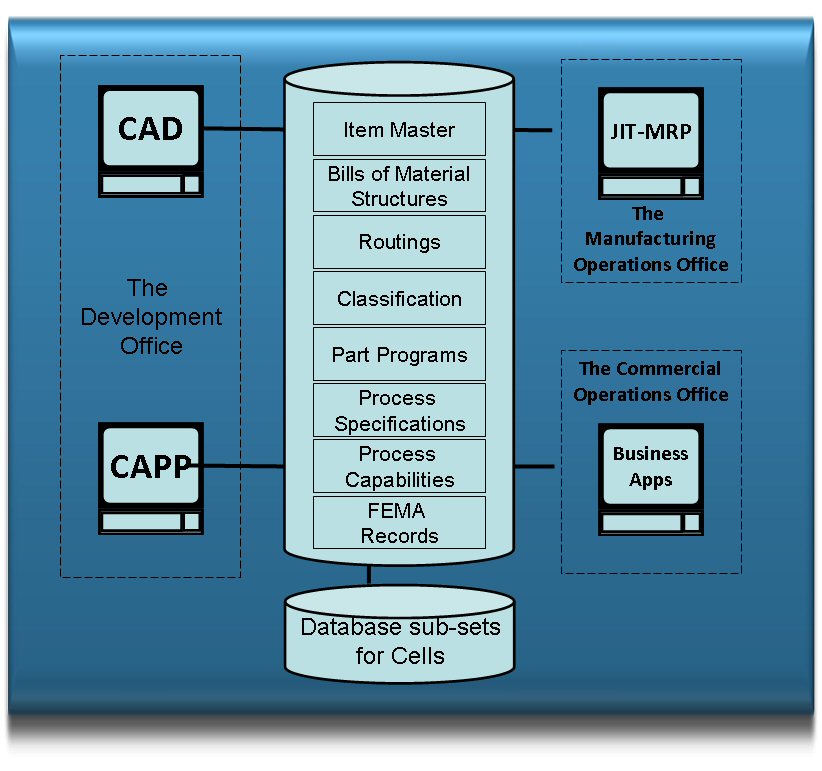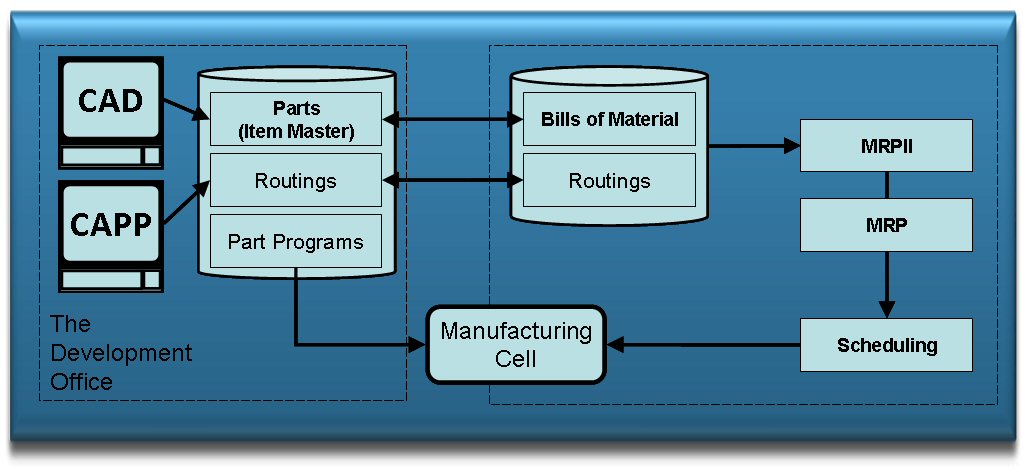7.16 - The Product Unit Integrated Engineering Database
Overview
Integrated means that each segment of a distributed database is designed to interface with and be compatible with others via specified inputs and outputs at the points of connection. See Systems Integration guide 7.21.

The first diagram shows that data should be held in the Product Units as a single database of integrated design. This has not always been possible as different areas of the business have required the same data to be in different formats. For example, the manufacturing operations requirement for data has differed from the development office requirement, leading to fragmented non-integrated databases.
Whilst the development office system simply requires a parts list for a new product, an MRPII system requires the parts list to be structured into a Bill of Materials that reflects the product’s manufacturing sequence, so as to allow work orders to be generated for every factory process. An MRPII system only requires a list of purchased parts and materials for the product, categorised by external supplier.
This has led to the two groups, and sometimes more, data being held separately as shown in the diagram above with consequent non-value-added activity to effect transfers between the two databases, together with a general drift in accuracy of one data set when compared to the other.
Introduction of Cells with JIT-MRP

The advent of cellular design of manufacturing systems together with JIT-MRP has allowed the resolution of the problem of needing two databases, in the following manner:-
Firstly, it has allowed decentralisation of the manufacturing planning function away from a central planning function down to the cell. This means it is only at the smaller cell database level that the manufacturing sequence needs to be reflected. The JIT-MRP system (which provides the materials procurement function) and the CAD systems now share the common requirement of only needing a parts list. The differing needs of JIT-MRP (which requires to have only the purchased items), from the CAD and CAPP system requirements to have all manufactured and bought out items, is achieved by holding the whole list but differentiating between the manufactured parts and the purchased parts by using a “make” or “buy” flag when using the data for purchasing.
The advantages of an integrated design for the Engineering Database are therefore:-
- Ease of matching system architecture to organisation structure, ownership’s and needs
- One accurate master set of data
- Allows for data to be used locally in cell database segments but based upon a derivative of the master set held centrally in the product unit development office.
- Designs are based upon accurate manufacturing data
- Manufacturing based upon accurate design data
- Performance measures can be applied
- And Input / Output analysis for each cell database segment ensures ease of interfacing the integrated database
- An integrated design allows storage of separate segments on separate PC’s without loss of integration
- Ownership of each segment, whether a development office segment of an operational cell segment is clear
- Simple interface links to other product units are easy to design by input / output analysis without relying on complex database management by committee across several product units
- Clear definition of these direct links to cells (e.g. for part program transfer to machine controllers to carry out CAM)
- To maintain accuracy and integration requires management to install a disciplined procedure for updating:-
- Each week the cell industrial engineers should meet with the Development Office Manager and agree jointly the database updates
- A single authority should then formally carry out and record the changes
Remember: a DISTRIBUTED database shall provide an integrated single data set for use by the business.
Notes:
PLM, PDM and associated technologies still continue to move at a rapid rate and in some cases out strips a company’s abilities to deploy the new levels of capability. However deployed appropriately and aggressively it can be a source of maintaining a competitive advantage and improving new product introduction rates.
important extension to the database would be to hold the materials data comparison tables to enable the materials selection function as described in guide 6.15.